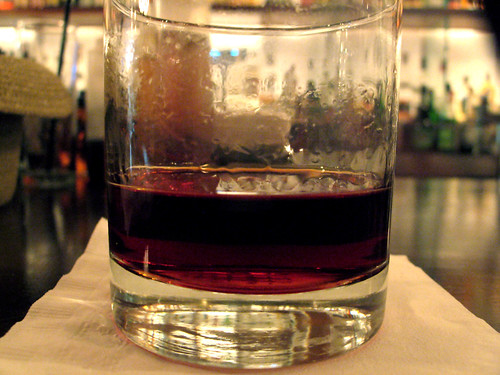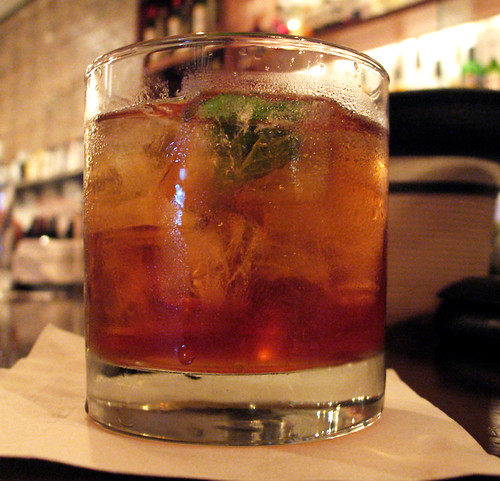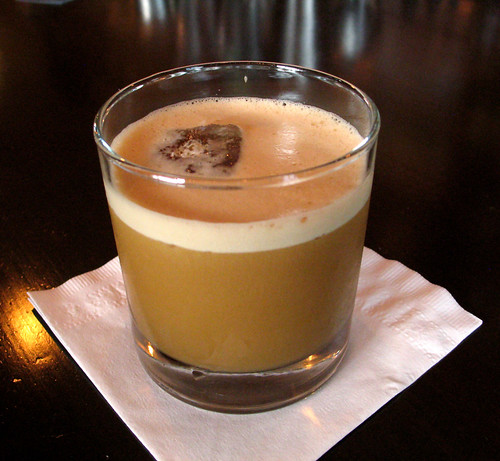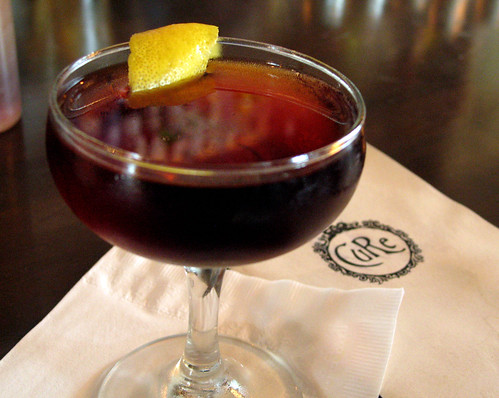Cocktail of the Day: The Animalito
Last night I finally participated in TDN, Thursday Drink Night. Sheesh, it’s about time.
TDN is a weekly gathering at The Mixoloseum Bar, a chat room where cocktail webbloggers, readers, enthusiasts, authors and even spirits industry folk gather on Thursday nights from 4pm-midnight Pacific time to make original cocktails, talk about them, make fun of each other and stay up too late. There’s a theme each week, whether it’s a specific product or a general base spirit or something like last night’s theme, “Equal Proportions.”
Can you make a good drink using equal proportions of the ingredients? Well sure, it’s been done all the time in cocktail history. My favorite example of this is the Negroni, equal parts of gin, Campari and sweet vermouth. The Sidecar began as an equally proportioned cocktail, of brandy, lemon juice and Cointreau. Thing is … that particular Sidecar doesn’t really taste balanced to me. I prefer it as 3:2:1, others at 2:1:1 (and some like the wacky Embury proportion of 8:2:1). Cocktails are all about balance, and when you’re constrained by a rule like this it can get tough to make a cocktail that’s properly balanced, and therein lay the challenge. The rules were to make an original cocktail using only equal proportions of your ingredients, with the exception being dashes of bitters or an egg white.
I was pretty happy with my entry, I must say. I started thinking about it on the way home, wanting to do something tequila-based and remembering something Misty Kalkofen of the bar Drink in Boston said recently, about how grapefruit bitters work well with yellow Chartreuse. DING! This one sprang fully-formed from my head, not unlike Athena. While I reserve the right to tweak the proportions later (e.g., the soda element won’t be constrained to the 3/4 ounce anymore, although I measured that amount in the original drink), I think it was pretty darn good as it was.
The grapefruit soda should be a high-quality one with a signifacant juice content. I thought that Ting, the Orangina-like grapefruit soda from Jamaica, would be ideal, but it’s not always easy to find. I couldn’t get to Galco’s before closing (and I knew they had some), so I ended up using IZZE Sparkling Grapefruit, which is 70% juices (grapefruit, apple, orange and white grape) with no added sugar. It had a terrific, fresh flavor and I think I’ll stick with this one, although I do want to try it with Ting. I wouldn’t use Fresca, but some of my bartender friends speak highly of Squirt, which I must confess I’ve never tried.
The name came from a rather infamous trip I took to Mexico back in college with some close friends. There were many adventures and inside jokes that survive until this day, and when I was trying to think of a name for a new tequila-based drink this one popped right out.
THE ANIMALITO
3/4 ounce añejo tequila (I used Partida).
3/4 ounce Laird’s bonded apple brandy.
3/4 ounce yellow Chartreuse.
3/4 ounce fresh lime juice.
2 dashes Bittermens Grapefruit Bitters (substitute Fee’s).
2 dashes Angostura Orange Bitters (substitute any other orange bitters).
IZZE Sparkling Grapefruit or Ting Grapefruit soda.
Grapefruit peel.Combine the firsts four ingredients with the bitters in an Old Fashioned glass. Add ice and stir for 15 seconds or so. Top with grapefruit soda and stir briefly. Garnish with grapefruit peel.
Tart and refreshing, with a nice little bitter edge! I liked this very much, and so did the folks in the Mixo Bar (thanks, y’all!). I may try making it shaken and up with half the bitters and no soda, just for kicks.
This drink is dedicated to Mr. John Norbutas. (“I want those goddamned Animalitos.” Long story.)









